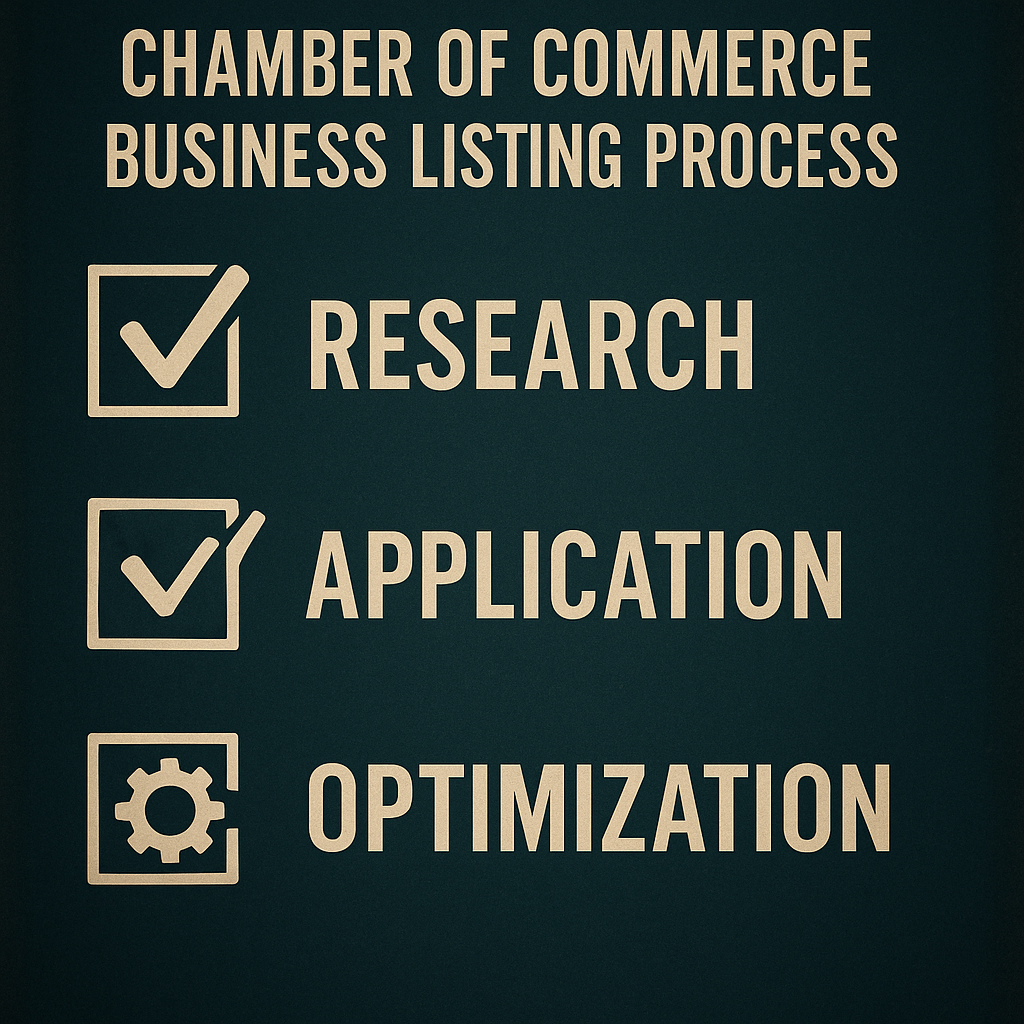The Ultimate Guide to Chamber of Commerce Business Listing (2025 Edition)
Everyone knows a chamber of commerce business listing is a proven tool for local credibility and customer trust.
But what does it really take to make your listing stand out and drive real results?
In this step-by-step cheatsheet, you’ll get everything you need: from joining the chamber to optimizing your listing for search engines and customers alike.
Some are quick wins you can do in under an hour.
Some are advanced strategies for next-level exposure and credibility.
Some are about leveraging networks and partnerships others overlook.
Some are surprisingly simple tweaks that boost your visibility overnight.
Some will help you avoid common mistakes that cost businesses leads and reputation.
Let’s dive right in.
- What Is a Chamber of Commerce Business Listing?
- Why Chamber Listings Matter in 2025
- Benefits of Joining and Getting Listed
- Step-by-Step: Getting Your Business Listed
- Optimizing Your Chamber of Commerce Business Listing
- Maximizing Chamber Membership for Growth
- Common Pitfalls and How to Avoid Them
- Measuring Success and Tracking ROI
- Conclusion & Next Steps
What Is a Chamber of Commerce Business Listing?
A chamber of commerce business listing is your company’s official profile in a local chamber’s online (and often print) business directory. It typically includes your business name, address, contact details, website, industry category, a description, and sometimes photos or special offers. Think of it as a premium business directory entry—one that’s community-validated and often referenced by local customers, media, and B2B buyers.
Unlike generic business directories or social media profiles, a chamber listing signals real-world credibility. It’s the digital handshake that shows you’re an active player in your local business ecosystem.

Why Chamber Listings Matter in 2025
It’s no exaggeration: chamber of commerce business listings are more influential than ever in 2025. Here’s why:
- Local search matters: Over 60% of all Google searches are now local, and chamber directories consistently rank on page one for "businesses near me."
- Trust signals: According to consumer studies, businesses that display chamber membership badges or are listed in a chamber directory see an immediate boost in trust and perceived professionalism.
- Networking and advocacy: Chambers don’t just list you—they advocate for you, connect you, and give your brand a seat at the table with local leaders.
- SEO power: Chamber listings provide high-quality backlinks and citations, which search engines use as a signal of authority and geographic relevance (source).
Still not convinced? Explore the ultimate guide to business directories for 2025 and see how chamber listings stack up.
Benefits of Joining and Getting Listed
Let’s break down the tangible benefits your business unlocks with a chamber of commerce business listing:
1. Instant Local Visibility
Your listing appears in a respected, high-traffic directory. Many chambers syndicate their directories to local government websites, partner organizations, and even Google Maps.
Some chambers also integrate with modern online directories—amplifying your reach even further.
2. Trust and Credibility
Being listed isn’t just a badge; it’s a filter. Chambers vet members, so customers browsing the directory know they’re dealing with legitimate, community-minded businesses (source).
3. Quality Backlinks & Local SEO
Chamber directory links are gold for local SEO. Google considers them authoritative, and they help your business appear in “near me” searches.
4. Networking and Growth
Chamber members gain access to exclusive events, mixers, workshops, and referral programs. These connections can lead to partnerships, B2B deals, and new customer pipelines.
5. Advocacy and Business Support
Chambers champion business-friendly policies at the local, state, and national levels (source). They also provide mentorship, resources, and sometimes even discounts or educational perks (such as university tuition discounts for members).
Step-by-Step: Getting Your Business Listed
Ready to get listed? Here’s a foolproof, step-by-step process for joining your local chamber and creating a standout business listing.
- Research Your Local Chamber
Find your primary city or county chamber. Some regions have multiple options (for industry, minority-owned, or regional focus). Compare their directories, event calendars, and membership tiers. Use resources like the U.S. Chamber of Commerce local finder for quick lookup. - Understand Membership Requirements & Fees
Membership fees vary—often based on business size or tier (basic, premium, corporate). Some chambers offer discounts for startups, nonprofits, or veterans. Download the membership application and clarify any perks (like educational discounts from university partnerships, as seen in this example). - Prepare Your Business Information
Gather your legal business name, DBA, address, contact person, phone number, email, website, a concise description, high-res logo, and a shortlist of keywords that describe your business. - Complete the Application
Most chambers offer simple online applications. Create a secure account in their portal. Fill every field with accuracy. Highlight what makes your business unique. - Submit Payment & Documents
Pay online or by check. Some chambers require supporting documents (business license, incorporation, insurance). - Verify and Optimize Your Listing
Once accepted, log in to the directory portal. Double-check your info. Upload images, verify links, and test everything before you go live.

Optimizing Your Chamber of Commerce Business Listing
Don’t stop at “just listed.” The difference between a basic and a high-impact listing is night and day. Here’s how to get the most SEO and customer value from your chamber of commerce business listing.
1. Nail Your Categories and Keywords
Choose categories that accurately reflect your products or services. Use targeted keywords—think like your customer. For example, a bakery should use keywords like “artisan sourdough,” “birthday cakes,” or “gluten-free treats.”
For more on keyword research and on-page SEO, see our company leads strategy guide.
2. Write a Compelling Business Description
Your description isn’t just a bio—it’s a sales pitch. Lead with your unique value. Use bullet points or short sentences for skimmability. Include a clear call-to-action (“Visit us for a free tasting!”).
3. Add High-Quality Images and Media
Upload crisp photos of your storefront, team, products, or community events. If the platform supports it, embed a short video introduction or testimonial. Visuals increase engagement and trust—plus, original images can improve SEO rankings (source).

4. Highlight Special Offers and Events
Many chambers let you post promotions or upcoming events. Use this to advertise seasonal deals, workshops, or open houses. Update regularly—fresh content keeps your listing top-of-mind and signals activity to both Google and customers.
5. Ensure NAP Consistency
Your Name, Address, and Phone number (NAP) should match exactly everywhere—your website, chamber listing, Google Business Profile, and other directories. Even small discrepancies ("St" vs. "Street") can hurt your local SEO.
6. Get Reviews and Testimonials
Encourage happy customers (and fellow members) to leave reviews on your listing, if the chamber directory supports it. Reviews are a powerful trust signal and can help you stand out in directory search results.
Maximizing Chamber Membership for Growth
Think of your chamber of commerce business listing as the beginning—not the end—of your membership journey. Here’s how to unlock exponential growth:
1. Engage at Events and Committees
Show up, volunteer, sponsor, or even host a workshop. The more visible you are, the more referrals and partnerships you’ll generate. Active members often get featured in newsletters and event promotions.
2. Leverage Chamber Communications
Pitch your business story, product launch, or milestone to the chamber’s communications team. Many chambers publish member spotlights, blog posts, or press releases that reach thousands of local eyeballs.
3. Build Relationships and Exchange Referrals
Follow up with new contacts and explore joint ventures. The chamber community is a goldmine for collaboration—don’t just collect business cards, nurture real relationships.
4. Tap Into Advocacy and Resources
Your chamber can help you navigate regulatory issues, access business planning tools, or connect you with mentors. Don’t be shy—ask for help and take full advantage of the resources offered (source).
How to Stand Out: Insider Tips from the Pros
Want to see what makes a chamber listing and application truly shine? Watch this insider video from the US Chamber’s CO—100 program for real-world advice, recognition, and practical next steps:
Common Pitfalls and How to Avoid Them
Even the best businesses can stumble. Here’s what to watch for (and how to fix it fast):
1. Incomplete or Inaccurate Information
Double-check every field—typos in your phone number or an outdated address can cost you leads. Update your listing any time your details change.
2. Ignoring Your Listing After Setup
An outdated profile makes your business look inactive. Calendar quarterly reviews to refresh images, descriptions, and offers.
3. Failing to Leverage Networking
Simply holding a membership card won’t generate results. Attend events, post in member forums, and reach out to other businesses. Proactive participation is where the ROI happens.
4. Neglecting SEO Basics
Don’t keyword-stuff your business name or use categories that don’t fit. Use relevant keywords in descriptions, but keep everything natural and user-friendly.
5. Inconsistent NAP Across Platforms
Remember: Even minor differences between your chamber listing, Google profile, and other directories can hurt your local rankings. Use a spreadsheet or SEO tool to audit your business citations regularly.
Measuring Success and Tracking ROI
How do you know your chamber of commerce business listing is working? Track these key metrics and use simple tools to tie results back to your efforts:
- Web Traffic: Monitor visits from the chamber directory to your site using UTM tracking links.
- Lead Volume: Count the number of inquiries, calls, or form fills that reference the chamber or come from directory links.
- Referral Growth: Track new business that comes from chamber events, partnerships, or member referrals.
- Event Attendance: If you participate in or host events, monitor sign-ups and engagement directly tied to your chamber activity.
Tools like Google Analytics, basic CRMs, or even spreadsheets can help you log and analyze this data. For more advanced tracking, check out our CRM data enrichment guide for workflow ideas.
Case Study: How Optimization Unlocks Growth
Case in point: A local café and bakery optimized its chamber listing by updating photos, adding targeted keywords, and posting monthly specials. In just three months, they saw a 30% spike in foot traffic and identified over 50 new customers who cited the chamber directory as their source.
Conclusion & Next Steps
Key Takeaways
- A chamber of commerce business listing is one of the most powerful, cost-effective ways to boost your local visibility, authority, and customer trust.
- Optimize every field with care—this isn’t just a directory; it’s a lead magnet and reputation builder.
- Chamber membership is a strategy, not a checkbox. Get involved, build relationships, and unlock the full suite of benefits—from networking to advocacy.
- Track your results and iterate: the most successful businesses treat their listing as a living asset, not a one-time task.
Action Plan & Timeline
- Week 1: Research chambers, gather business data, and submit your application.
- Week 2: Finalize payment, upload media, and verify your listing information.
- Weeks 3–4: Attend at least one chamber event, and pitch your story or offer to the chamber’s communication team.
- Month 2+: Schedule quarterly reviews of your profile and set up KPI tracking routines.
Further Resources
For ongoing success, explore your chamber’s resource center, subscribe to industry newsletters, and stay engaged in professional communities. Keep learning, stay visible, and your chamber of commerce business listing will pay dividends for years to come.
Need more on business directories, lead generation, or advanced local SEO? Visit our main blog page for the latest in growth and digital marketing.
Last updated July 16, 2025. For more expert business resources, visit the U.S. Chamber of Commerce.